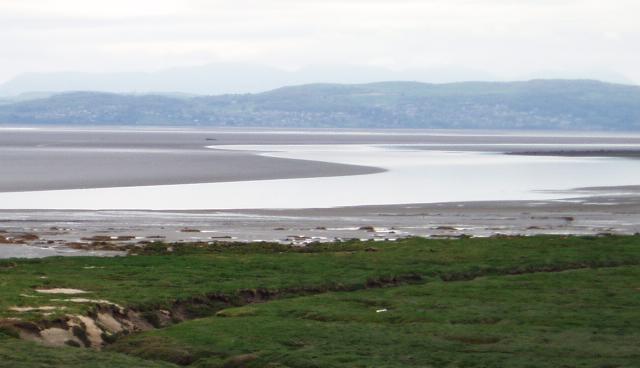|
Lindale, Cumbria
Lindale - traditionally Lindale in Cartmel - is a village in the south of Cumbria. It lies on the north-eastern side of Morecambe Bay, England. It was part of Lancashire from 1182 to 1974. It is in the civil parish of Lindale and Newton-in-Cartmel, in South Lakeland district. History Lindale's most famous resident was John "Iron-Mad" Wilkinson, an ironworker and inventor who lived in the village from 1750, where he owned the Castle Head estate. He produced the iron for and helped design the world's first iron bridge (at Ironbridge and Broseley) and he made the world's first iron boat in 1787. A large iron obelisk stands in the village as memorial to him. Traditionally a farming village, Lindale's proximity to the A590 road has seen a growth in the number of commuters who live there. It is also a centre for car showrooms. The local tourist boom has largely missed Lindale, with nearby Grange-over-Sands developing into a seaside resort, and villages to the north and west (such as ... [...More Info...] [...Related Items...] OR: [Wikipedia] [Google] [Baidu] |
Lindale And Newton-in-Cartmel
Lindale and Newton-in-Cartmel, formerly Upper Allithwaite (sometimes Allithwaite Upper) is a civil parish in South Lakeland, Cumbria, England. The spelling Lindale and Newton in Cartmel, without hyphens, is used by the parish council. The parish includes the villages of Lindale, High Newton and Low Newton and lies north of Grange-over-Sands. The parish has an area of and in the UK census 2011 had a population of 842. History Upper Allithwaite was formerly a township in the parish of Cartmel, in 1866 Upper Allithwaite became a civil parish in its own right. The parish was renamed from "Upper Allithwaite" to "Lindale and Newton-in-Cartmel" on 16 April 2018 as the new name provides a clearer description of the geographical area. Listed buildings There are 15 listed buildings or structures in the parish, including St Paul's church, Lindale and the grade II* listed Barrow Wife, a former Quaker Quakers are people who belong to a historically Protestant Christian set of ... [...More Info...] [...Related Items...] OR: [Wikipedia] [Google] [Baidu] |
National Parks Of England And Wales
National parks of the United Kingdom ( cy, parciau cenedlaethol; gd, pàircean nàiseanta) are areas of relatively undeveloped and scenic landscape across the country. Despite their name, they are quite different from national parks in many other countries, which are usually owned and managed by governments as protected community resources, and which do not usually include permanent human communities. In the United Kingdom, an area designated as a national park may include substantial settlements and human land uses that are often integral parts of the landscape. Land within national parks remains largely in private ownership. These parks are therefore not "national parks" according to the internationally accepted standard of the IUCN but they are areas of outstanding landscape where planning controls are a little more restrictive than elsewhere. Within the United Kingdom there are fourteen national parks of which nine are in England, three in Wales and two in Scotland. There ... [...More Info...] [...Related Items...] OR: [Wikipedia] [Google] [Baidu] |
Grange Over Sands
Grange-over-Sands is a town and civil parish located on the north side of Morecambe Bay in Cumbria, England, a few miles south of the Lake District National Park. In the 2001 census the parish had a population of 4,042, increasing at the 2011 census to 4,114. Historically part of Lancashire, the town was created as an urban district in 1894. Since the 1974 local government re-organisation, it has been of the South Lakeland district of Cumbria, though it remains part of the Duchy of Lancaster. Travelling by road, Grange-over-Sands is to the south of Kendal, to the east of Ulverston, to the east of Barrow-in-Furness and to the west of Lancaster. History The town developed in the Victorian era from a small fishing village and the arrival of the railway in 1857 made it a popular seaside resort on the north side of Morecambe Bay, across the sands from Morecambe. The "over-Sands" suffix was added in the late 19th or early 20th century by the local vicar, who was fed up ... [...More Info...] [...Related Items...] OR: [Wikipedia] [Google] [Baidu] |
Milnthorpe
Milnthorpe is a small market town on the southern border of Cumbria, 7 miles south of Kendal, civil parish and electoral ward are in the South Lakeland district of Cumbria, England. Historically in the county of Westmorland and on the A6, the town contains several old hostelries and hosts a market every Friday. The parish, which includes the small village of Ackenthwaite, had a population of 2,199 according to the 2011 Census. History Milnthorpe is the site of the 19th-century Church of St Thomas, which overlooks Overlooking The Green and The Square designed by Kendal architect George Webster. Prior to its construction Milnthorpe was in the parish of Heversham. Milnthorpe became a centre of business and activity because it was originally a port, using the River Bela and estuary (now only navigable to Arnside), and it remains a significant commercial centre for the area. Tourism and hospitality have always thrived, Milnthorpe being a convenient stop-off point on the A6 for ... [...More Info...] [...Related Items...] OR: [Wikipedia] [Google] [Baidu] |

